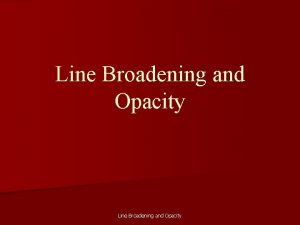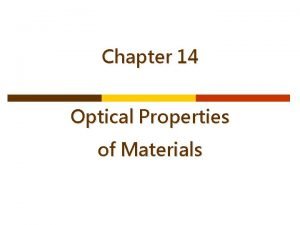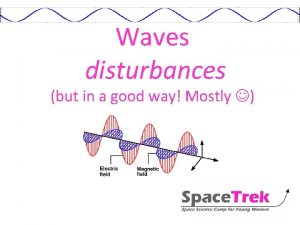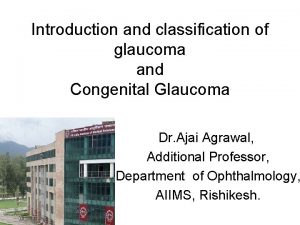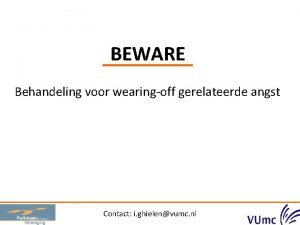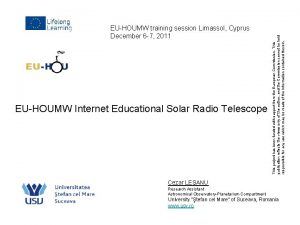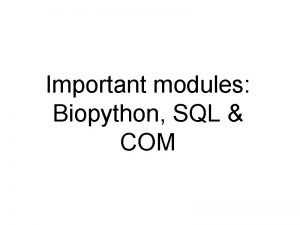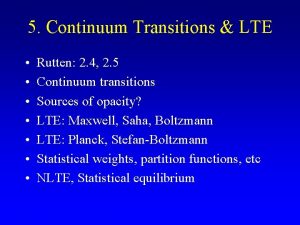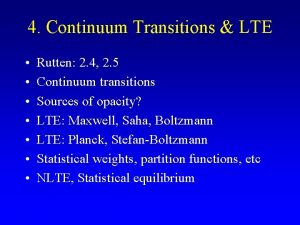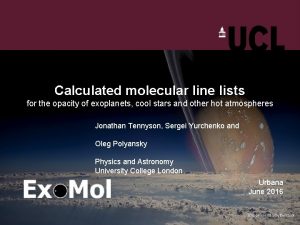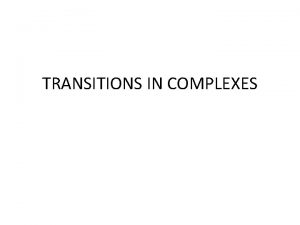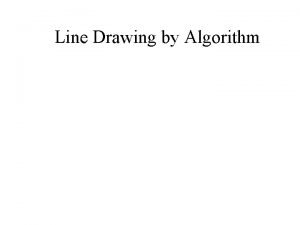4 Transitions Opacity Rutten 2 3 Line transitions









![Formal Coefficients The monochromatic line extinction coefficient per m 3 is Where the […] Formal Coefficients The monochromatic line extinction coefficient per m 3 is Where the […]](https://slidetodoc.com/presentation_image_h2/c6c917b754881672371ea2234d35fee2/image-10.jpg)



- Slides: 13

4. Transitions & Opacity • Rutten: 2. 3 • Line transitions • Einstein coefficients & relations

Sources of Opacity • • Bound-bound transitions Bound-free transitions Free-free transitions (Bremstrahlung) Scattering: electrons, molecules, dust, … Calculate total opacity from where ni is the number density of absorbers/scatteres, and si is the cross section of the process.

Bound-Bound Line Transitions Bound-bound transitions between upper u and lower l levels of an atom, ion, or molecule may occur as Radiative Excitation Spontaneous Radiative De-excitation Induced Radiative De-excitation Collisional Excitation Collisional De-excitation We use the Einstein Coefficients to describe these processes,

Spontaneous De-excitation Transition probability for spontaneous de-excitation from state u to state l per second per particle in state u With no collisions or other transitions, the mean lifetime of particles in state u is Dt = 1/Aul seconds. The corresponding spread in energy is (Heisenberg) DE = h/(2 p Dt) or Dn = grad/2 p with grad = 1/Dt the radiative damping constant. This “natural” broadening process defines an emission probability distribution y(n – n 0) around line center, n 0, given by the area-normalized Lorentz profile: The Aul coefficient is a summation over the profile, describing the transition probability for the whole line.

We’ll discuss the emission profile shape and other broadening mechanisms in more detail later. Other mechanisms are usually much more important than radiative damping. For a static atmosphere and assuming each deexcitation is independent of the preceding processes that put the atom in state u, i. e. , complete redistribution, we get with Doppler width: Where m is the particle mass and H(a, n) is the Voigt function. It is Gaussian at line centre due to Doppler shifts from Maxwellian motions (Doppler core) and has extended wings caused by collisions perturbations (Damping wings). The emission profile is more complex when frequency redistribution is incomplete (partial redistribution), which happens if the emitted photon is correlated with the photon that excited the atom in a scattering up-down sequence. Coherent scattering (no n change) is the other extreme.

Radiative Excitation Number of radiative excitations from state l to state u per second per particle in state l With the index n 0 defining a specific spectral line whose extinction profile j(n – n 0) is used in weighting the angle-averaged exciting radiation field over the spectral extent of the line A more general expression which also holds when j(n – n 0) is anisotropic due to systematic Doppler shifts is:

Induced De-excitation Number of induced radiative de-excitations from state u to state l per second per particle in state u similarly to Blu, with frequency averaging: in which c(n – n 0) is the area-normalized profile shape for induced emission.

Collisional Excitation / De-excitation Number of collisional excitations from state l to state u per second per particle in state l Number of collisional de-excitations from state u to state l per second per particle in state u Electron collisions (usually most important) causing transitions from state i to state j have With Ne the electron density, sij(v) the electron cross section, f(v) the area-normalized velocity distribution (usually Maxwellian) with mean value vf(v)dv, and v 0 the threshold velocity mv 02/2 = hn 0. sij is a material property of each transition independent of external state parameters except velocity v. Similar to bb cross section, Aul, Blu

Einstein Relations The Einstein coefficients coupled by the Einstein relations: g = statistical weight or degeneracy: g = 2 J + 1
![Formal Coefficients The monochromatic line extinction coefficient per m 3 is Where the Formal Coefficients The monochromatic line extinction coefficient per m 3 is Where the […]](https://slidetodoc.com/presentation_image_h2/c6c917b754881672371ea2234d35fee2/image-10.jpg)
Formal Coefficients The monochromatic line extinction coefficient per m 3 is Where the […] term corrects for induced emission, taken into account as negative extinction. The total line extinction coefficient is Using hn j(n – n 0) dn ~ hn 0 j(n – n 0) dn = hn 0 since lines are narrow. Throughout these notes, n 0 denotes summation or averaging over the line profile.

The monochromatic line extinction coefficient per particle is, without correction for induced emission The total line extinction coefficient per particle is The latter is an ensemble-averaged extinction coefficient, given per particle, but averaged over the distribution specified by j(n – n 0). The parameter flu is the classical dimensionless oscillator strength. This was originally introduced to correct harmonic-oscillator line strength predictions for unknown quantum mechanical effects. Resonance lines such as Ly a have flu ~ 1. The n-dependences give with DEul = hn 0, the transition energy. Numerically:

The monochromatic line emission coefficient expressed in Einstein coefficients is, without induced emission: The line source function is or using the Einstein relations

For complete redistribution the profile shapes are equal, f = j = c, so the line source function simplifies to: We’ll see that this simplifies to Sn = Bn when the population ratio nl / nu obeys the Boltzmann distribution for LTE.
